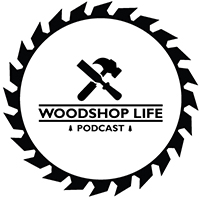Brians Questions:
Thanks for sharing your knowledge and opinions – and answering my previous questions. It’s been a great help.
My shop is in my single car garage, which I share with household storage. It has a very high ceiling. I recently got a good deal on a new Jet AFS-1000B Air Filtration System. (note: I do not have a dust collection system, as I try to do mostly hand tool work, but I do use power tools as needed. So there is plenty of dust).
The question is: where to locate the device?
The options are:
- I have a shelf that is suspended from the ceiling and could test to see if it will support the Jet unit.
- There is a metal storage cabinet that I can set it on, and attach to the wall (per Jet instructions).
- Place it on the lower shelf of my Moravian style workbench.
Attaching it directly to the ceiling is out, as it is too high, and I don’t have ladders or scaffolding to get up there.
The easiest is option 3 – on the lower shelf of the workbench. Will it be effective down there – about a foot off the ground? Or should I go for options 1 or 2?
Thanks for any insight.
David V. – Baltimore, MD
Gentlemen,
Thank you for taking the time out of your busy schedules to share your knowledge through the podcast. I’ve recently caught up on all the previous episodes and really look forward to the bi-weekly insights you provide. It’s been a tremendous help as I navigate the early stages of woodworking and material sourcing.
I have a question regarding quality expectations when purchasing from regional hardwood suppliers. I’ve recently started buying from a distributor in the Texas/Oklahoma area that operates multiple warehouses. While I’m still relatively new to this type of procurement, I’ve noticed a gap between what I expected from a “select & better” grade product and what I actually received.
My recent order was for cherry lumber—select & better, RW&L, averaging 6 inches wide, 9 feet long, and 15/16″ thickness, graded 90/70+. The issue I encountered was significant end-checking and splitting—some boards had cracks extending 10 to 18 inches. Since the lumber (along with some maple and walnut) was bundled and strapped to a pallet, it wasn’t until I got home—over an hour away—that I realized the extent of the damage.
I understand that some waste is always part of the equation, but I’m trying to get a sense of what’s considered “normal” for a premium grade. Should I have contacted the supplier once I noticed the issue? Or is it standard practice to inspect the order before it leaves the yard? I’d appreciate any guidance or rules of thumb you might recommend for handling situations like this.
Thanks again for your time and for all the valuable information you share. It’s been a huge help.
Best regards, Mark
Guys Questions:
I’m preparing to build a set of kitchen cupboards from white oak. The style will be Mission, with some Frank Lloyd Wright Prairies Style touches. I have several questions.
I’m going to build some assembly tables. I don’t want hundreds of dog/hold-down holes in each, but I will probably drill a few. I’m wondering about 3/4” (the traditional North American standard) vs. 20 mm (a standard popularized by Festool, etc.). I know this isn’t a black and white choice, but could you share some thoughts on what one might consider before committing to one size vs. another. Darrin
I frequently seem to struggle with keeping the countersink concentric concentric with the screw clearance hole.
I have both the multi-flue countersink and the countersink with one diagonal hole but they both want to wander.
I also have a tapered drill bit with set-screwed countersink. Maybe I should be trying harder to use that type.
So my question is – do you have any suggestions for keeping the countersink centered on the clearance hole, and what is your preferred type of countersink.
Steve
Huys Questions:
Hello guys, my name is Jim Rose. I live in north central Kansas and have a couple of completely different topics for questions.
Before the questions, I wanted to say, thanks so much for an awesome podcast. I have been a listener since Brian came on board. In fact, the 1st episode I listened to was his 1st episode!!!
First off, I have a question about beetle kill pine. I am currently building a new house and have purchased beetle kill pine to put on the walls and ceiling of a sunroom. My question is what finish should I use if any so that the blues and reds of the beetle kill pine will show the best and not change colors in anyway. I have seen different opinions on the internet ranging from a clear poly to nothing at all. Some have even said that a finish will change to colors which I definitely dont want. Not sure if this is true so thought I would the experts. Thanks in advance. Any suggestions/advice would be greatly appreciated.
Thanks again, Jim
Hey Fellas’ as many say “love the podcast”, I’ve learned a ton and look forward to more as I work my way through previous shows and keep up with new ones. The ask … you’ve shared a fair amount regarding adhesive/glues including talking shelf life. How can we tell when an adhesive/glue has exceeded its shelf life and should be discarded and replaced? I mean knowing this is prior to using it and the project failing and pieces not sticking as needed. Thanks, Chris Hudson
